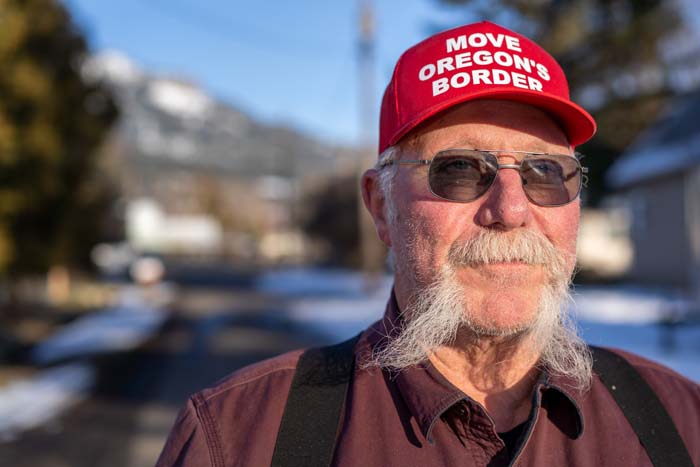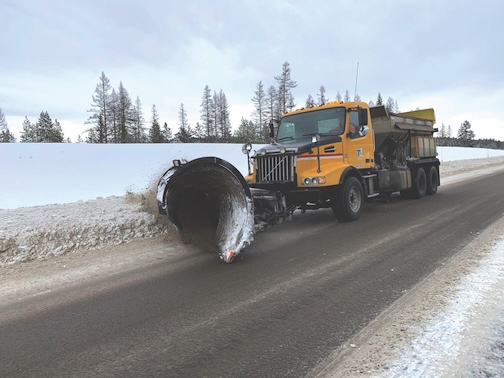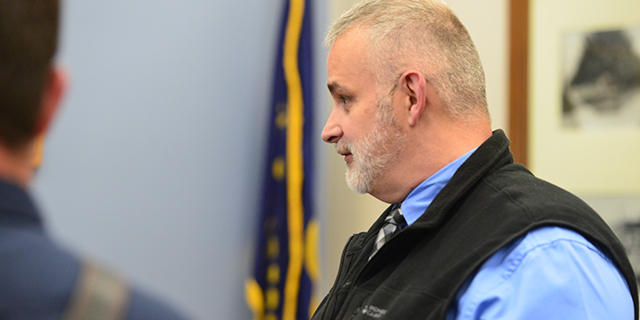Creating a Greater Idaho buzz
Published 7:00 am Thursday, March 3, 2022

- Grant Darrow, a retired chimney sweep and Cove resident, poses for a photo outside his home on Saturday, Feb. 26, 2022. Darrow has been leading local efforts in the campaign to change the Oregon-Idaho border and allow Eastern Oregon to become part of Greater Idaho.
COVE — Grant Darrow is a man of letters.
Trending
The Cove resident has penned so many letters to newspapers over the past four decades about pressing issues that he has lost count.
One stands out, however, with the grandeur of 12,662-foot Borah Peak in Central Idaho. It is a letter clipped from The Observer and kept in a black notebook. The letter is fading slightly, unlike the movement it helped ignite. Darrow, in his 391-word piece, published in The Observer on June 29, 2015, pushed for a sea change — the moving of Idaho’s border west so that it could include Eastern Oregon and other rural portions of the state.
“Imagine for a moment Idaho’s western border stretching to the Pacific,” Darrow wrote at the end of the letter.
Trending
Almost seven years later, many Oregonians are imagining just as he hoped they would, which means the the Greater Idaho movement is gaining momentum.
“We are gaining support,” Darrow said. “This is an exciting time.”
Those who have taken note include The Atlantic magazine, which refers to Greater Idaho as “Modern America’s Most Successful Secessionist Movement” in a story that appeared in its Dec. 23, 2021, edition.
Darrow is not surprised by the growing momentum, especially when he reflects on the response his letter received in the days and weeks after it was first published. He said about 40 other rural Oregon newspapers printed the letter after he sent it to them.
“Some newspapers even called me up and requested a copy so they could run it,” he said.
Darrow said McCarter played an instrumental role in getting Measure 31-101 on the Union County ballot in 2020. The measure, which voters approved with a little more than 52% of the vote, requires the county commissioners to meet three times each year to discuss promoting Union County interests relating to the county becoming part of Idaho.
Today, the letter, which stated that Eastern Oregon should be part of Idaho because its people are ignored by Oregon’s west-side leaders, is viewed as so integral to the Greater Idaho movement that a copy is reprinted on the website of a leading group pushing for Greater Idaho — Move Oregon’s Border, whose leader is Mike McCarter, of La Pine.
Darrow credits McCarter with doing much of the heavy lifting, which has given Greater Idaho the momentum it now has.
“I put into words what people are feeling, and Mike puts legs under it,” he said.
“Even though this has been talked about for 100 years, Grant’s letter piqued the interest of a lot of people in Eastern and Southern Oregon,” McCarter said.
McCarter credits Darrow’s letter with leading to the initial meetings in La Pine of what is today Move Oregon’s Border.
“Grant is an integral part of this,” McCarter said.
Union County provides a boost
A total of 7,401 cast ballots in support of the Union County measure. Darrow believes that everyone who voted for Measure 31-101 are supporters of Greater Idaho. He said Union County is not alone in its support of Greater Idaho. Darrow noted that Malheur, Baker, Grant, Harney, Sherman, Lake and Jefferson counties have all passed similar measures. He also said Klamath, Douglas and Josephine counties will likely vote on comparable measures in May.
He said the measures are making it possible for people to civilly voice their frustration. Darrow explained that when people believe they are disenfranchised they can react either violently or peacefully. Measure 31-101 and similar initiatives are providing people an opportunity to do the latter.
“These are pressure valves that allow people to react in a positive manner,” he said.
Darrow collected more than 700 signatures of registered voters to get Measure 31-101 on the ballot in Union County.
“I could not believe it when we got on the ballot,” he said.
Darrow said based on what people told him, most everyone who signed the Union County petition supports Greater Idaho, but he knows of several who did not.
“One woman signed it because she wanted to see it get on the ballot so that she could vote against it,” Darrow said.
Such responses did not bother Darrow, who said his ultimate objective is to give the people a chance to decide about Greater Idaho.
“That is what citizen government is all about,” he said. “It is about dialogue.”
Darrow said that while he was collecting signatures for Measure 31-101 he told people, “I am not here to argue or convince you. I am here to give you a chance to vote.”
A plea to legislators
Since the passage of Measure 31-101 Darrow has been urging the Union County Board of Commissioners to request in writing that State Rep. Bobby Levy, R-Echo, and State Sen. Bill Hansell, R-Athena, work to get Oregon legislators to discuss Greater Idaho.
Darrow said he is not requesting that formal discussions about Greater Idaho begin at that state capital. Darrow said it could be something as simple as the formation of a committee to try to determine why interest in Greater Idaho is growing.
“Getting people at the state level to talk about it is the next step,” he said. “We need to get more dialogue, to get everybody talking about it. We have to get it out there.”
Darrow said he has a firsthand understanding of the growing sense of frustration people in Northeastern Oregon have about the state’s urban-rural divide because he worked as a chimney sweep in Union, Wallowa and Baker counties for 44 years before retiring in September 2021.
“I would work in 12 to 15 homes a week,” he said.
The chimney sweep has detected a growing sense of disenchantment with Oregon’s government during the past decade, noting they believe, like Darrow does, that the needs and concerns of Eastern Oregon are largely ignored by the Legislature.
“We have become nothing more than window dressing,” he said.
Darrow in his 2015 letter to the editor expressed this point even more starkly.
“It would appear to any rural resident or outside observer that most of Oregon’s urbanites view Oregon’s rural residents as nothing more than third-world inhabitants occupying their weekend and vacation playgrounds in what they advertise to the world as Oregon’s unique diversity,” he wrote.
Regulations are choking businesses
Darrow objects to things such as the way state government is imposing more and more regulations and fees that make it increasingly difficult for Oregonians to start and operate businesses in Oregon.
“It has gotten so bad that I could not afford to start a career as a chimney sweep in Oregon today,” he said, adding that every time government puts in a new regulation or fee it adds to the red tape citizens must deal with. “It gets to be absolutely crazy.”
Darrow does not know what Greater Idaho will lead to, noting that it may push to something beneficial to rural Oregon that might not involve moving Idaho’s borders west.
“It could morph into any direction,” he said.
He believes the Greater Idaho campaign could lead to a positive change in how the Legislature perceives rural residents, the creation of a new state or Greater Idaho
The Cove resident is sometimes asked by people who know how much he dislikes Oregon’s urban-rural divide, why he doesn’t move to Idaho.
“I tell them, ‘That is what I am trying to do,’” Darrow said.









